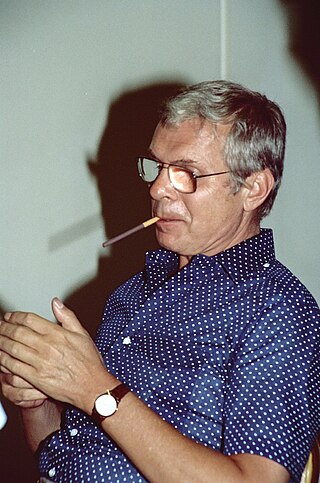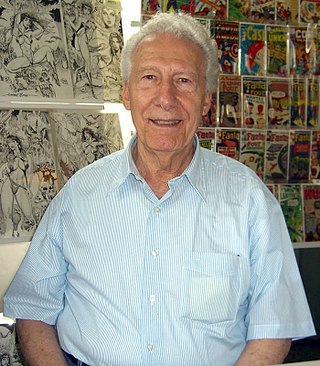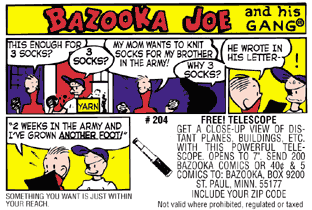A comic strip is a sequence of cartoons, arranged in interrelated panels to display brief humor or form a narrative, often serialized, with text in balloons and captions. Traditionally, throughout the 20th and into the 21st century, these have been published in newspapers and magazines, with daily horizontal strips printed in black-and-white in newspapers, while Sunday papers offered longer sequences in special color comics sections. With the advent of the internet, online comic strips began to appear as webcomics.

Mars Attacks is a science fiction-themed trading card series released in 1962 by Topps. The cards feature artwork by science fiction artists Wally Wood and Norman Saunders. The cards form a story arc, which tells of the invasion of Earth by cruel, hideous Martians under the command of a corrupt Martian government who conceal the fact from the Martian populace that Mars is doomed to explode and, therefore, proposes colonization of Earth to turn it into their new homeworld. The cards depict futuristic battle scenes and bizarre methods of Martian attack, torture and slaughter of humans, as well as various Earth nations being attacked. The story concludes with an expeditionary force of humans volunteering to embark on a counterattack on Mars, in which the Earth force attacks the Martians in their manner. This necessitates the Martians that are still on Mars to defend their homeworld. The Earth attack forces, after destroying the Martian cities and killing the Martians, depart just before Mars is destroyed in the predicted cataclysm, thus ensuring the peace and safety of Earth as the Martian race is seemingly doomed to extinction.

Harold Rudolf Foster, FRSA was a Canadian-American comic strip artist and writer best known as the creator of the comic strip Prince Valiant. His drawing style is noted for its high level of draftsmanship and attention to detail.

Itzhak Avraham ben Zeev Spiegelman, professionally known as Art Spiegelman, is an American cartoonist, editor, and comics advocate best known for his graphic novel Maus. His work as co-editor on the comics magazines Arcade and Raw has been influential, and from 1992 he spent a decade as contributing artist for The New Yorker. He is married to designer and editor Françoise Mouly, and is the father of writer Nadja Spiegelman. In September 2022, the National Book Foundation announced that he would receive the Medal for Distinguished Contribution to American Letters.

The Topps Company, Inc. is an American company that manufactures trading cards and other collectibles. Formerly based in New York City, Topps is best known as a leading producer of baseball and other sports and non-sports themed trading cards. Topps also produces cards under the brand names Allen & Ginter and Bowman.
Bazooka is an American brand of bubble gum that was introduced in 1947. It is a product of "Bazooka Candy Brands" (BCB), which was a division of The Topps Co. until the latter’s acquisition by Fanatics, Inc. in 2022.

Buster Brown is a comic-strip character created in 1902 by Richard F. Outcault. Adopted as the mascot of the Brown Shoe Company in 1904, Buster Brown, along with Mary Jane, and with his dog Tige, became well known to the American public in the early 20th century. The character's name was used to describe a popular style of suit for young boys, the Buster Brown suit, that reflected his outfit.

Popsicle is a Good Humor-Breyers brand of ice pop consisting of flavored, colored ice on a stick.

John Burton Davis Jr. was an American cartoonist and illustrator, known for his advertising art, magazine covers, film posters, record album art, and numerous comic book stories. He was one of the founding cartoonists for Mad in 1952. His cartoon characters are characterized by extremely distorted anatomy, including big heads, skinny legs, and large feet.

Basil Wolverton was an American cartoonist and illustrator known for his intricately detailed grotesques of bizarre or misshapen people. Wolverton was described as "Producer of Preposterous Pictures of Peculiar People who Prowl this Perplexing Planet." His many publishers included Marvel Comics and Mad magazine.

Leonard Starr was an American cartoonist, comic book artist, and advertising artist, best known for creating the newspaper comic strip On Stage and reviving Little Orphan Annie.

Richard Allen Kulpa was an American cartoonist best known for his work for Cracked and Weekly World News.

Joe Giella was an American comic book artist best known as a DC Comics inker during the late 1950s and 1960s period which historians and fans call the Silver Age of Comic Books. Due to his long and prolific career, Giella has been described as "one of the creators synonymous with the Silver Age of Comics."
George Wildman was an American cartoonist most noted for his work in the comic books industry. From 1971 until 1985 he was a top editor at Charlton Comics, where he also became the long-time regular artist on Popeye comic books.

Jay Patrick Lynch was an American cartoonist who played a key role in the underground comix movement with his Bijou Funnies and other titles. He is best known for his comic strip Nard n' Pat and the running gag Um tut sut. His work is sometimes signed Jayzey Lynch. Lynch was the main writer for Bazooka Joe comics from 1967 to 1990; he contributed to Mad, and in the 2000s expanded into the children's book field.
Wee Pals is an American syndicated comic strip about a diverse group of children, created and produced by Morrie Turner. It was the first comic strip syndicated in the United States to have a cast of diverse ethnicity, dubbed the "Rainbow Gang".
Wesley Morse was an American cartoonist who is most famous for his creation of the Bazooka Joe comic strip for the bubble gum company Topps in 1953. He also created the Copa girl, which was the basis for the Copacabana logo.

Woodrow Gelman was a publisher, cartoonist, novelist and an artist-writer for both animation and comic books. As the publisher of Nostalgia Press, he pioneered the reprinting of vintage comic strips in quality hardcovers and trade paperbacks. As an editor and art director for two-and-a-half decades at Topps Chewing Gum, he introduced many innovations in trading cards and humor products.
Prizes are promotional items—small toys, games, trading cards, collectables, and other small items of nominal value—found in packages of brand-name retail products that are included in the price of the product with the intent to boost sales, similar to toys in kid's meals. Collectable prizes produced in series are used extensively—as a loyalty marketing program—in food, drink, and other retail products to increase sales through repeat purchases from collectors. Prizes have been distributed through bread, candy, cereal, cheese, chips, crackers, laundry detergent, margarine, popcorn, and soft drinks. The types of prizes have included comics, fortunes, jokes, key rings, magic tricks, models, pin-back buttons, plastic mini-spoons, puzzles, riddles, stickers, temporary tattoos, tazos, trade cards, trading cards, and small toys. Prizes are sometimes referred to as "in-pack" premiums, although historically the word "premium" has been used to denote an item that is not packaged with the product and requires a proof of purchase and/or a small additional payment to cover shipping and/or handling charges.
Len Brown is an American writer, editor, radio personality and comic book scripter, best known as the co-creator of T.H.U.N.D.E.R. Agents and Mars Attacks.













